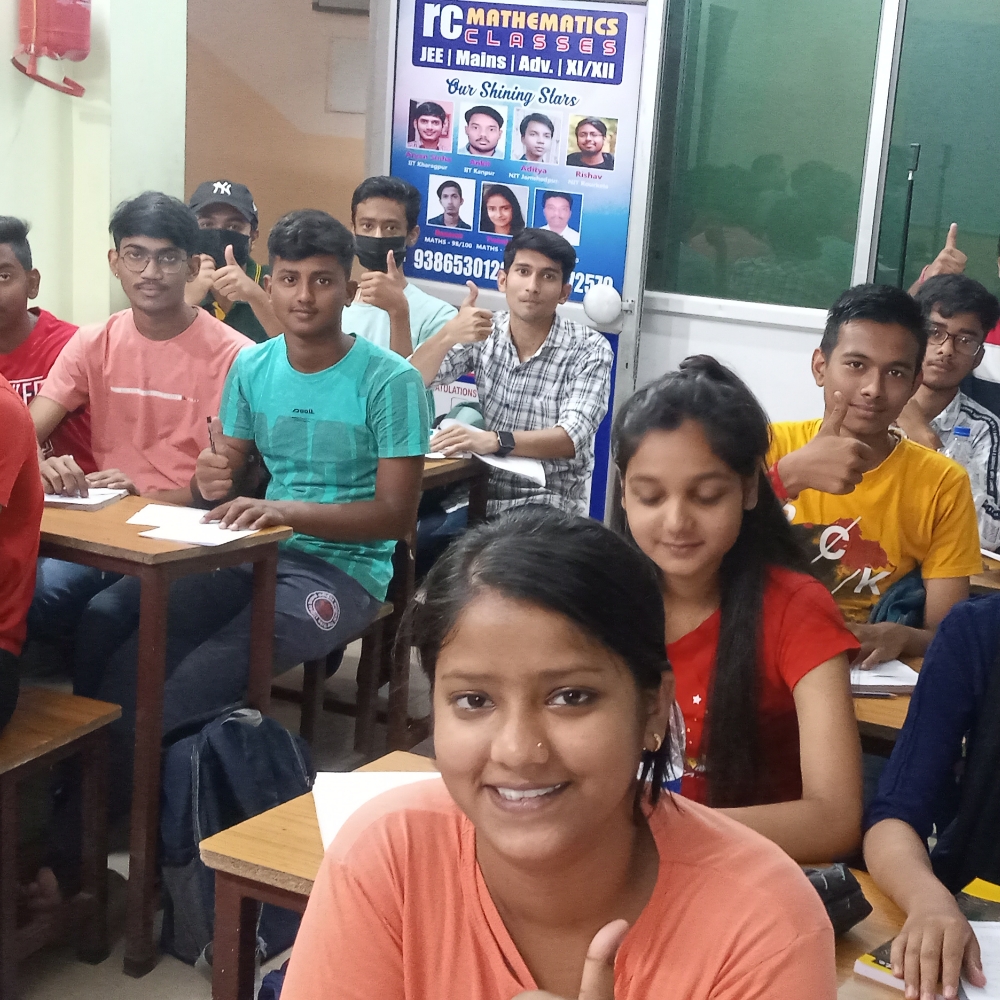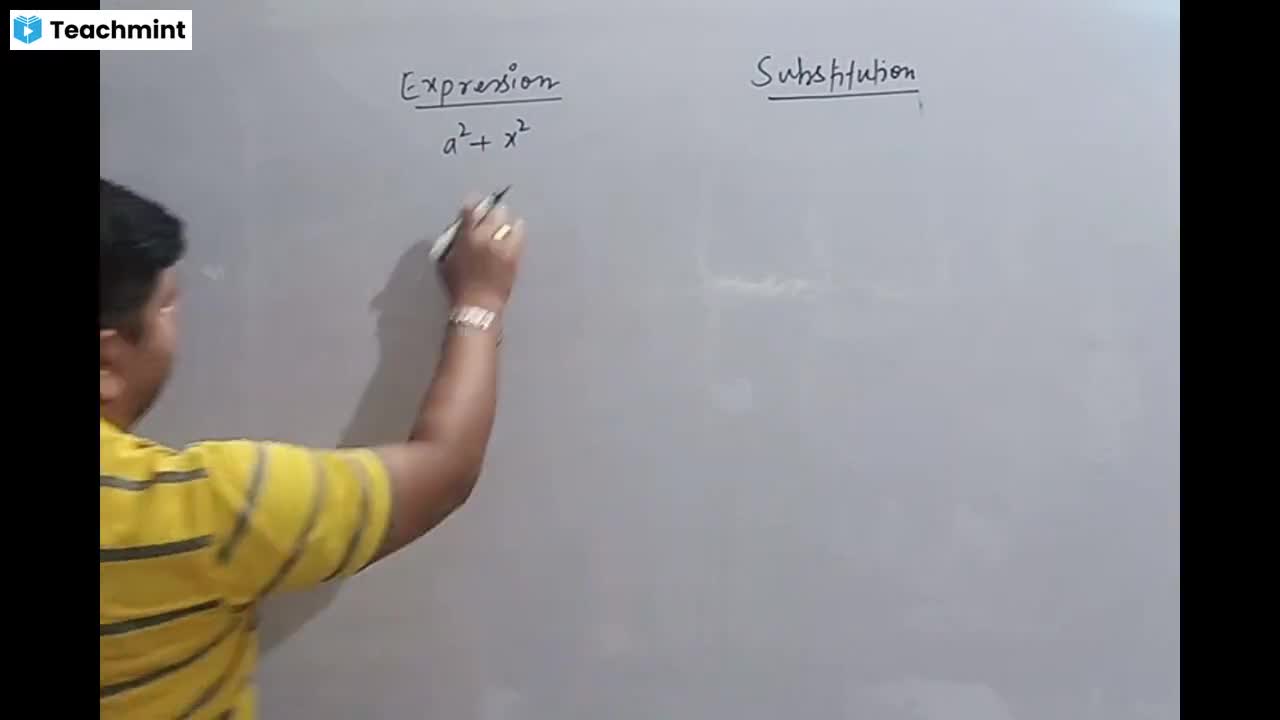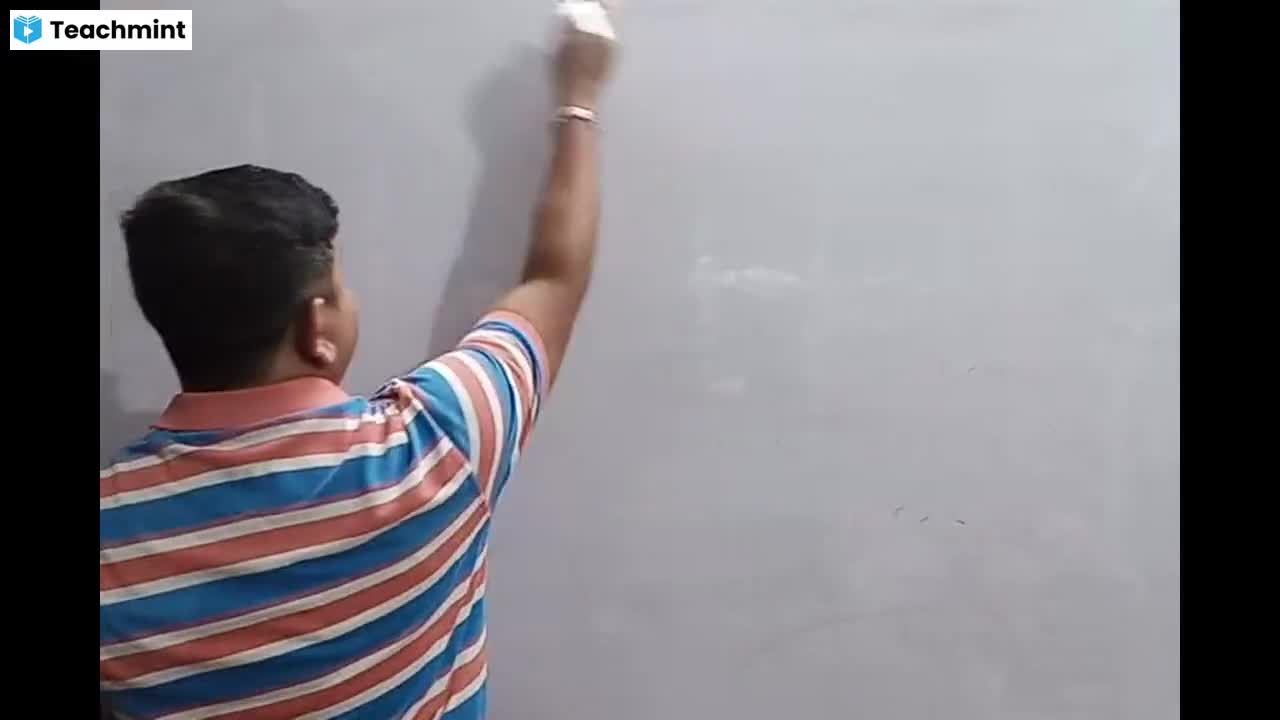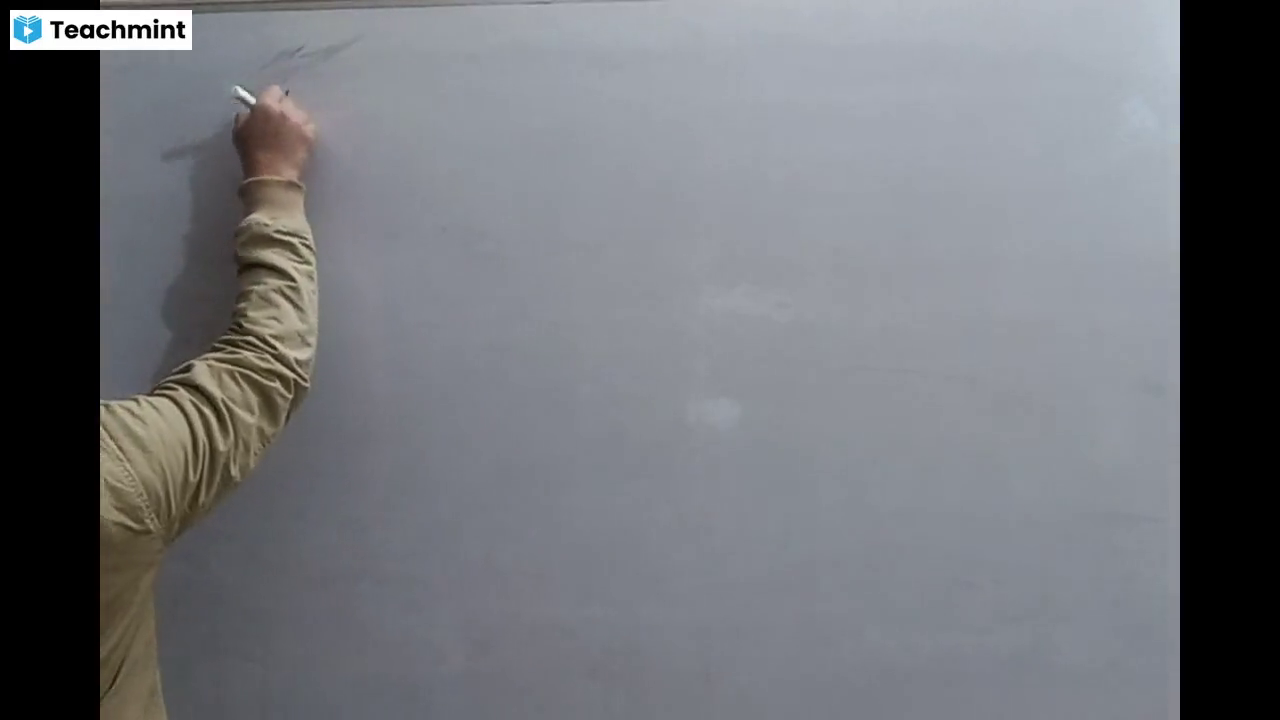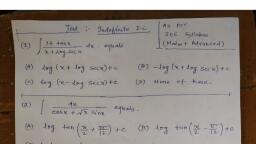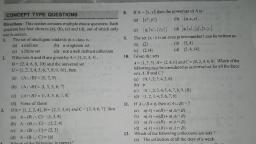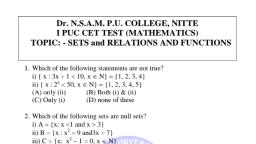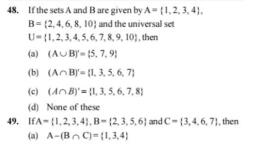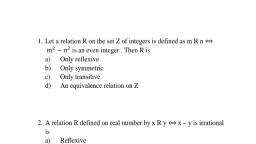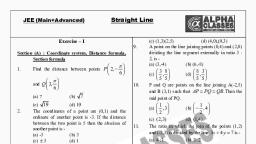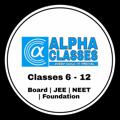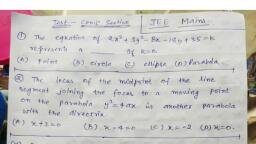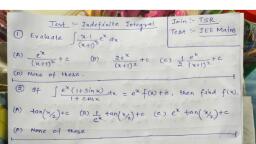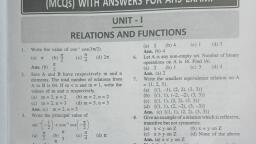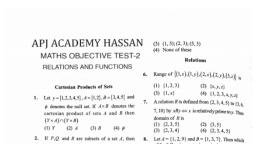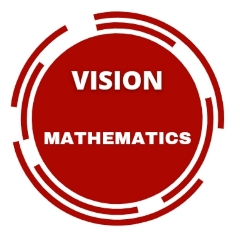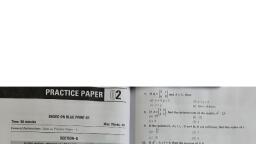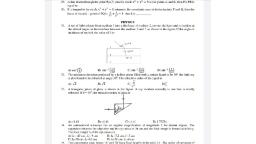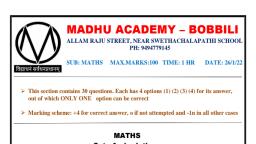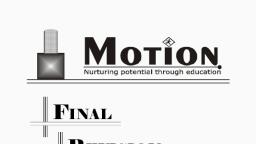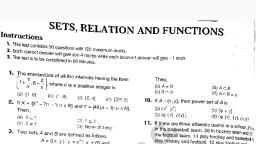Page 1 :
A relation on the set A= {x: |x| <3, x z} where Z, is the set of integers is defined by, R=[{(x. y):y=|s|,.1%-1} then the no. of elements in the power set of R, , (a) 32 (b) 16 (8 (d) 64, , Let X =[1, 2,3,4,5}. The no, of different ordered pairs (Y, Z) that can formed such that, YCX.Z,CX and ¥ OZ is empty is, , (a) S () @ 2% @s, , Ina certain town 25% of the families own a phone and 15% own a car, 65% families own neither a phone, nor a car und 2000 families own both a car and a phone. Consider the following three statements, , (A) 5% families own both a car and a phone, (B) 35% families own either a car or a phone, (C) 40,000 families live in the town then, , (a) Only A & C over truc (b) Only B & C are true, , (c) AILA, B & C are true (d) Only A & B are true, , If A, B and C are three sets such that AM B = ANCand AUB=AUC thea, , fa) A=C () B=C (@ANB=o (@) A=B, , Let S=(xeR,x20 and ahr ~3]+-Vi(x-6)+6=0 then S, , , , (a) contains exactly ane elements (b) contain exactly two elements, , (c) contain exactly 4 elements (d) is an empty set, , Let r={s.245- = a tenis, , (a) An empty set (b) not an empty set —(c) A singleton set (d) None of these, ‘The symmetric difference of A and B is not equal to, , (a) (A=B)9(B-A) (b) (A-B)U(B-A), , (@ (AVB)-(AnB) @ {((AVB)-A}U{(AUB)-B}, For any sets A and B, (A-B)U(B-A)=, , (a) (A-B)UA (b) (B-A)UB (c) (AVB)-(AMB) @) (AUB)O(AnB), For any three sets A, B and C, , (a) AA(B-C)=(AMB)-(Anc) (b) AN(B-C)=(ANB)-C, , (c) AU(B-C)=(AUB)n(AvuC) (d) AU(B-C)=(AUB)-(AUC), , | The set (AUBUC}A(ANBINC) UC’, , (a) BAC’ ) ANC () BUC @Anc, , . If Aand B are two given sets then A( AB)’ is, , (a)A ®)B (o id) ANB’
Page 2 :
15., , 18., , . If R is arelation defined on the set A = {1 2,3} by the rule (a,b) €R > |a* ~B*, , Let S = the set of points inside square, T = the set of poims inside A and C = the set of points inside, circle intersect each other are contained in square, , a SATAC=6 ) SUTUCES @ SUTUC=C @ SuT=SOC, If R={(x, y):a, ye c,x7 + y? <4} is reaction on z then domain of R is, , (a) {0,1, 2) () {0,-1,-2} (c) {-2,-1,0,1,2} (@) None, , Arelation > from e to Ris defined by x@ y <> [x = y, which one is correct, , (a) (2+3i)o13 (b) 39(-3) (©) (I+i)$2 (ipl, , Let n(A)=m, n(B)=0 then total no. of non empty relation that can be defined from A to B is, (a) m" ) a"=1 (©) mn-t (@ 2-1, , The relation R defined on the set A ={1, 2,3, 4, 5} by R={(a.b): a -b'|<16} is given by, (a) {(1.1), (2.1), (3.1), (4.1), (2.3) (by {(2, 2), (3,2), (4, 2),(2.4)}, , (©) {(3.3).(4.3).(5.4).(3.4)} (8) None of these, , A relation R is defined from {2 34, 5} to {3,6,7, 10} by x R y is relatively prime to y then domain, of R is, , (a) {2,35} ©) {3,5} (© {23,4} @ {2,3,4,5}, , 1A={1, 2,4}, B={2, 4.5}, C= {2,5} then (A-B)(B-C) is, a) {(1,2),(1.5).(2.5)} @&) {(L4)} © (1.4) (4) None of these, |. For real nos x and y define x R y iff xy 4V2 is an irrational no. which one is true relation., , (a) (x, x)ER (b) (x, y)ER and (y,x)eR, (©) (a, y)eR and (y,2)eR then (x,z)eR — (d) None of these, WA={x2xew.x<2}, B={x:xeN.1<x<5}, C= {3,5} then Ax(BOC)is, (a) {(3.0).@.1)} b) {(0.3).(1.3)} © {(0,3),(3.1))— @) None, , $5 then R'=?, , , , (a) {(1.1), (2,1), (1.2). (2, 2). (3,2), (2.3). (3.3)}, , «by {(2.1), (3,2). (2,3). (3.3), , (© {(2.3),(.2).(3.3).(12).(2.2)}, , (d) None, , Lat R= ({(x, y):a.ye2,y=2x—4). If (a,—2) and (4,0°) belongs to R then, , (a) a=tlb=2 ) a=-1,b=2 © a=l,b=+2 (d) None
Page 3 :
23. The no. of elements in the domain and Range of the relation R defined on the set Z of integers as follows:, (a,b)eROa’ +b’ =25, , D=6 Dal D=7, , ) ), , (b), R=6 R=6 R=7, , a (d) None, , 24. Let R=({(a,a'):aisa prime no. less than 5} be a relation then Range of R, , (a) {2,8} () {3,27} (c) {8,27} (d) None, , 25. Let A= {2,3,4,5}, B= {1, 3,4} IPR is the relation from A to B given by a Rb iff “@ isu divisor of, b” write R as set of ordered pairs, , ca) {(2.4).(4.4).(3.3)} ( {(4.2).(2.2).(3.4)}, (e) {(4,3), (3.4)} (d) None-of these
